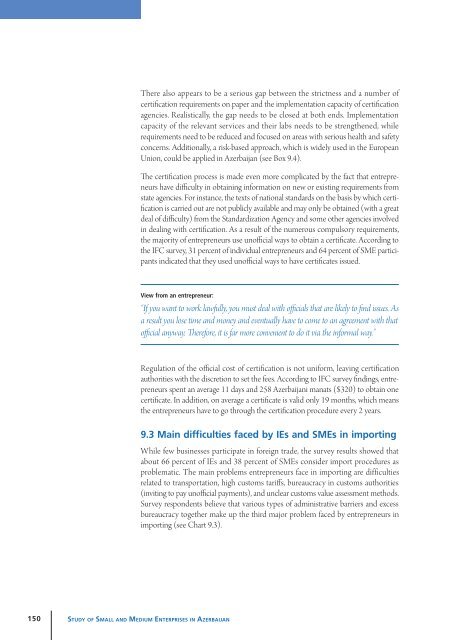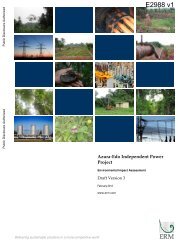Study of Small and Medium Enterprises in Azerbaijan - IFC
Study of Small and Medium Enterprises in Azerbaijan - IFC
Study of Small and Medium Enterprises in Azerbaijan - IFC
Create successful ePaper yourself
Turn your PDF publications into a flip-book with our unique Google optimized e-Paper software.
There also appears to be a serious gap between the strictness <strong>and</strong> a number <strong>of</strong><br />
certification requirements on paper <strong>and</strong> the implementation capacity <strong>of</strong> certification<br />
agencies. Realistically, the gap needs to be closed at both ends. Implementation<br />
capacity <strong>of</strong> the relevant services <strong>and</strong> their labs needs to be strengthened, while<br />
requirements need to be reduced <strong>and</strong> focused on areas with serious health <strong>and</strong> safety<br />
concerns. Additionally, a risk-based approach, which is widely used <strong>in</strong> the European<br />
Union, could be applied <strong>in</strong> <strong>Azerbaijan</strong> (see Box 9.4).<br />
The certification process is made even more complicated by the fact that entrepreneurs<br />
have difficulty <strong>in</strong> obta<strong>in</strong><strong>in</strong>g <strong>in</strong>formation on new or exist<strong>in</strong>g requirements from<br />
state agencies. For <strong>in</strong>stance, the texts <strong>of</strong> national st<strong>and</strong>ards on the basis by which certification<br />
is carried out are not publicly available <strong>and</strong> may only be obta<strong>in</strong>ed (with a great<br />
deal <strong>of</strong> difficulty) from the St<strong>and</strong>ardization Agency <strong>and</strong> some other agencies <strong>in</strong>volved<br />
<strong>in</strong> deal<strong>in</strong>g with certification. As a result <strong>of</strong> the numerous compulsory requirements,<br />
the majority <strong>of</strong> entrepreneurs use un<strong>of</strong>ficial ways to obta<strong>in</strong> a certificate. Accord<strong>in</strong>g to<br />
the <strong>IFC</strong> survey, 31 percent <strong>of</strong> <strong>in</strong>dividual entrepreneurs <strong>and</strong> 64 percent <strong>of</strong> SME participants<br />
<strong>in</strong>dicated that they used un<strong>of</strong>ficial ways to have certificates issued.<br />
View from an entrepreneur:<br />
“If you want to work lawfully, you must deal with <strong>of</strong>ficials that are likely to f<strong>in</strong>d issues. As<br />
a result you lose time <strong>and</strong> money <strong>and</strong> eventually have to come to an agreement with that<br />
<strong>of</strong>ficial anyway. Therefore, it is far more convenient to do it via the <strong>in</strong>formal way.”<br />
Regulation <strong>of</strong> the <strong>of</strong>ficial cost <strong>of</strong> certification is not uniform, leav<strong>in</strong>g certification<br />
authorities with the discretion to set the fees. Accord<strong>in</strong>g to <strong>IFC</strong> survey f<strong>in</strong>d<strong>in</strong>gs, entrepreneurs<br />
spent an average 11 days <strong>and</strong> 258 <strong>Azerbaijan</strong>i manats ($320) to obta<strong>in</strong> one<br />
certificate. In addition, on average a certificate is valid only 19 months, which means<br />
the entrepreneurs have to go through the certification procedure every 2 years.<br />
9.3 Ma<strong>in</strong> difficulties faced by IEs <strong>and</strong> SMEs <strong>in</strong> import<strong>in</strong>g<br />
While few bus<strong>in</strong>esses participate <strong>in</strong> foreign trade, the survey results showed that<br />
about 66 percent <strong>of</strong> IEs <strong>and</strong> 38 percent <strong>of</strong> SMEs consider import procedures as<br />
problematic. The ma<strong>in</strong> problems entrepreneurs face <strong>in</strong> import<strong>in</strong>g are difficulties<br />
related to transportation, high customs tariffs, bureaucracy <strong>in</strong> customs authorities<br />
(<strong>in</strong>vit<strong>in</strong>g to pay un<strong>of</strong>ficial payments), <strong>and</strong> unclear customs value assessment methods.<br />
Survey respondents believe that various types <strong>of</strong> adm<strong>in</strong>istrative barriers <strong>and</strong> excess<br />
bureaucracy together make up the third major problem faced by entrepreneurs <strong>in</strong><br />
import<strong>in</strong>g (see Chart 9.3).<br />
150<br />
St u d y o f Sma l l a n d Me d i u m Ent e r p r i s es <strong>in</strong> Az e r b a i j a n

















